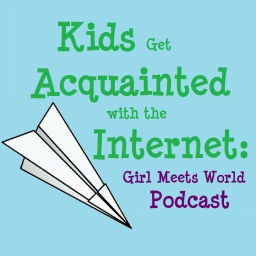 The following is a guest blog post by Gemma and Nan. If you’re interested in contributing to this blog contact us with your ideas and we’ll look them over.
The following is a guest blog post by Gemma and Nan. If you’re interested in contributing to this blog contact us with your ideas and we’ll look them over.
The Merriam Online Dictionary says that a “friend” is… never mind. If the Girl Meets World episode Girl Meets I Am Farkle taught me anything it’s that labels and definitions are just words. They’re helpful when learning about something but they tend to shortchange the meaning of the words or in Farkle’s case, be wrong. I prefer to define words by my personal experiences with them when I can. To me, chiefly, a friend is someone who is always there for me and tells me what I need to hear, whether that friend is a real person or not.
That’s why I choose to consider the characters of Boy Meets World my friends. I invited them into my home and we hung out every Friday night for over two years (I started watching the show in October 1997) and they taught me the importance of education when I was apathetic towards it, friendship when I didn’t believe in it, and family when I wanted to rebel against it. Now I invite them and their families in again when I watch Girl, and new friendships are forming. Continuing to watch Boy as it exists in syndication has made stronger my appreciation for not only the characters but the actors & actresses who play them, so my pool of friends deepens as they are added to it.
October 10th is World Mental Health Day and recently I found out that a few particular friends have been on a journey with their mental health. That and seeing the kids research Asperger’s Syndrome in Girl Meets I Am Farkle has inspired me, with the expertise of my fellow blogger Nan (a licensed mental health counsellor in Jacksonville, Florida), to learn more about what my friends have dealt with. One’s mental health can be affected by many different conditions but henceforth Nan will be delving into Anxiety Disorder, Panic Disorder and Bipolar Disorder.
“Of course it’s happening inside your head Harry. But why on earth should that mean that it is not real?” – Professor Albus Dumbledore
What Are Anxiety And Panic Disorders?
They both involve fear. To be fair, fear is a very useful emotion to have and it’s kept humans alive for many millennia, but fear should be temporary as it is a response that is meant to help us only when we are in danger. When fear or worry (hallmarks of anxiety) have gotten in the way of one’s daily life for an extended period of time, and it’s out of proportion with a situation, it is possibly an Anxiety Disorder. They are disorders that shares symptoms of anxiety with certain behavioural responses to it. The different types are: Generalized Anxiety Disorder, Separation Anxiety Disorder, Selective Mutism, Social Anxiety Disorder and Agoraphobia. Obsessive-Compulsive Disorder and trauma-related disorders such as Post Traumatic Stress Disorder used to be included but now both are their own categories. A Panic Disorder involves repeated Panic Attacks and the thing that produces the anxiety is often merely the possibility of an “attack” itself.
What Are Panic Attacks And What Are The Signs And Symptoms?
Panic Attacks are surges of sudden intense fear and physical discomfort that typically last several minutes. The discomfort may include nausea, intense fear of death, chills, dizziness, difficulty breathing, etc. They don’t just happen in Panic Disorder, they can occur with almost every type of Anxiety Disorder and a bunch of other conditions such as depression. They can also happen for no reason at all.
What Causes Anxiety Disorders And What Are The Signs And Symptoms?
Lots of things contribute to anxiety disorders. They can be caused by specific phobias, medications, substances like drugs and alcohol (and the guilt that accompanies overly indulging in them) excessive caffeine intake, a medical condition, etc. Problems with how the brain communicates with itself (brain chemistry) factors in too. There is also a genetic link (anxiety disorders can run in families) and the environment is also a huge factor.
…Not that environment. If things happen or happened around a person (in their environment) causing trauma, those things can be a factor.
Some of the symptoms that occur in the category include: restlessness, tiredness, tension, sleep issues, inability to concentrate and of course, fear and worry. Panic Attacks are a symptom as well.
Are Symptoms Real or Are They Just All in One’s Head?
Both. Worry and fear are emotions produced in our minds, and emotions result from thoughts we have and things we have learned or tell ourselves. These could be based in reality or exaggerated by insecurities or past experiences but the physical responses the emotions produced are definitely not imagined. The stress response includes complex interactions of brain chemicals and hormones that produce very real effects on the body. Whether or not the “threat” is perceived or real, the body treats it the same way.
What Are The Most Effective Anxiety Disorder Treatments?
After diagnosis by a psychotherapist or medical professional who has specific education in the criteria, lifestyle changes (quitting smoking, caffeine, etc.), psychotherapy and medication are the options. The “go-to” therapy for anxiety is Cognitive Behavioral Therapy (CBT). One of my personal favourites, CBT addresses both the mind and body components of anxiety disorders. Cognitive strategies address the thoughts that are producing fear and anxiety. Behavioral techniques like relaxation training help with the body’s stress response. Medications may be helpful, but I will leave that to the medical professionals.
How Common Are Anxiety Disorders And Panic Attacks?
In the United States the lifetime statistics (the percentage of people who at SOME point in their life will experience these issues) is 28.8% for Anxiety Disorders and 4.7% for Panic Disorder. Panic Disorder usually occurs during or after adolescence.
“Normality is a paved road: it’s comfortable to walk, but no flowers grow on it.” – Vincent Van Gogh
What Is Bipolar Disorder And What Causes It?
Bipolar Disorder has traditionally been considered a Mood Disorder because it involves the presence of mood changes. There are a few types: Bipolar I, Bipolar II, Cyclothymic Disorder and specific types that involve medications, medical conditions, etc.
All Bipolar Disorders involve the experience of different “episodes”. A Manic Episode is a period of elevated activity and energy that can last at least a week. A person experiencing one may neglect sleep, talk A LOT, get distracted, be extremely preoccupied with achieving a goal, have racing incoherent thoughts, and behave impulsively (like excessively shopping or gambling, while ignoring the consequences). A Hypomanic Episode is similar but symptoms only have to be there for at least 4 days, not a whole week. A Major Depressive Episode involves a two week period when a person has a low mood, little energy, difficulty sleeping even when they want to, changes in weight, feelings of worthlessness, suicidal thoughts, an inability to concentrate, and agitation.
In order to be considered Bipolar I a person has to have experienced a Manic Episode. Hypomanic and Depressive episodes often happen but a person can still have Bipolar I even if they don’t. People with Bipolar II have at least one Hypomanic Episode and at least one Major Depressive Episode, but no Manic Episodes. Cyclothymic Disorder involves hypomanic symptoms that do not meet criteria for a Hypomanic Episode. Periods with depressive symptoms that do not meet criteria for a Major Depressive Episode happen as well.
WOO! Did you guys get all of that? Nan’s really rocking this eh? GIF break!
After diagnosis through psychological evaluation and physical examination, medication or psychotherapy is used. Mood stabilizers are the primary treatment and in more severe Manic Episodes hospitalization may be necessary. This is different than before with Anxiety Disorders where medication is only used if lifestyle changes and therapy aren’t working. Medication is much more significant to the management of Bipolar Disorder. Mood stabilizers help control the occurrence of Manic, Hypomanic, and Depressive Episodes. CBT along with medication management has also been effective in managing Bipolar.
It’s Common For People To Avoid Treatment. Why?
Unfortunately many diagnoses come with a social stigma, and Bipolar is no different. Often when experiencing a manic or hypomanic episode the person with the disorder may not feel that they need help (due to feelings of grandeur and impulsivity) or they may have had negative experiences from times they have sought help in the past. The possibilities are endless.
How Common Is Bipolar Disorder?
The lifetime statistics for is Bipolar 3.9% of people in the United States. The median age of onset is 25 years (National Institute of Mental Health), although it can start in early childhood or as late as the 40’s and 50’s.
Please know that while we wanted to spread awareness of these circumstances with this blog post all of it is just words. Neither Nan nor I have personal experiences with these words so undoubtedly we are shortchanging the meaning of them for people who do. But if Girl Meets World is right and the secret of life is that people change people then we all wield the power to take these words and the knowledge (hopefully) gained from them to be there for our friends in the mental health community and tell them what they need to hear, and they should hear sentiments of, chiefly, support and understanding. Doing that puts “order” in “disorder” as it helps change the way people cope with and view these situations, potentially creating new friendships and definitely strengthening existing ones like Farkle and Isadora’s in Girl Meets I Am Farkle. That strength is important because as we all know there is another secret of life:
“Lose one friend, lose all friends, lose yourself.” – Eric Matthews/ Plays With Squirrels
For more information check out The Canadian Mental Health Association if you’re in Canada like me or the National Institute of Mental Health if you’re in the United States like Nan.
Sources:
http://psychiatryonline.org/guidelines
http://www.dbsalliance.org/site/PageServer?pagename=education_statistics_bipolar_disorder
https://www.cmha.ca/mental-health/understanding-mental-illness/anxiety-disorders/
http://behavenet.com/apa-diagnostic-classification-dsm-iv-tr
http://www.terapiacognitiva.eu/dwl/dsm5/DSM-5.pdf







Leave a comment